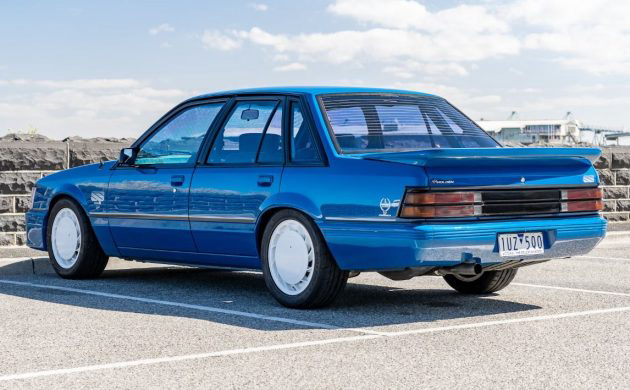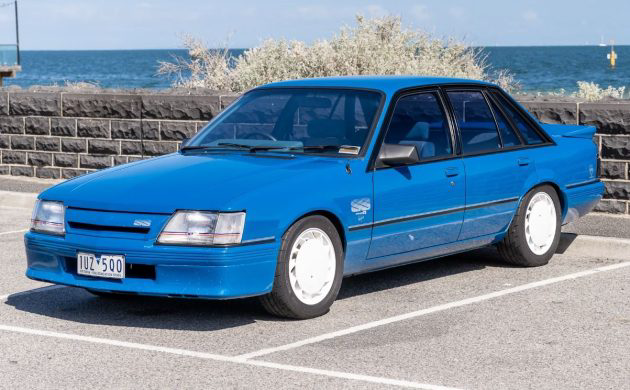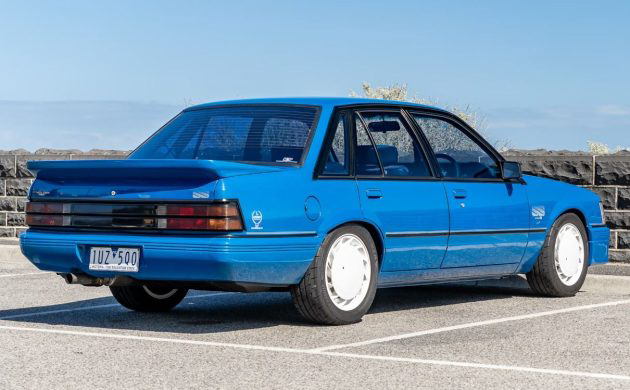
By 1985, Australian racing legend Peter Brock was riding the crest of a wave. He had steered his factory-backed racing team to four wins in five years in the iconic Bathurst 1000 endurance race, and his multi-million dollar HDT Special Vehicles Division was producing some of Australia’s most potent and desirable road cars. Few people knew that the man’s relationship with Holden was only two years from imploding, but this 1985 Commodore Group A SS demonstrates better than most cars how strong the relationship was at its peak. This Group A isn’t just 1-of-500 examples built for racing homologation but is documented as being Brock’s former daily driver. A previous owner sold the Commodore in May 2021 for a record price, and it is crossing the auction blocks again. The Group A is listed here on Collecting Cars in Melbourne, Victoria, Australia. Bidding sits at A$300,500 with under two days remaining on the auction.

Readers outside Australia probably deserve insight into this Commodore and what makes it genuinely desirable. The muscle car scene Down Under draws many parallels with North America, but two-door models form only a small part of its history. This has little to do with buyer reluctance but results from the limited market size. Australia’s population has only recently topped twenty-six million, making our new car market considerably smaller than North America’s. Therefore, producing anything beyond family four-door sedans was not economically viable. Ford, Holden, and Chrysler tried with their Falcon Hardtop, Monaro, and Charger, respectively, but none were huge sales successes. Manufacturers turned to their sedan models as a viable alternative, with the Falcon GTHO and Torana A9X shining examples of this philosophy. Holden was one victim of the General Motors global “no racing” philosophy, although it found ways to circumvent that decree. It provided support “in kind” to competitors, and as we will see, this extended beyond a few plugs and filters. When the Australian motor racing scene transitioned from a domestic formula to International Group A Touring Cars, Holden left no stone unturned when collaborating with Peter Brock’s HDT Special Vehicles Division to produce a homologation special Commodore designed to take on the world.

The Holden Commodore first broke cover in 1978, marking a change in design philosophy for the company. It had previously relied on its Torana and Kingswood models to fill the medium and large car market, but the Commodore slotted between and replaced both. Its styling was deliberately cutting-edge European, and after a relatively slow start, the Commodore would become the backbone of Holden’s range for over four decades. The First Generation underwent four facelifts, but each was considered a new model by the buying public. The VK variant, the third such upgrade, graced showroom floors from 1984 until 1986. It retained its predecessor’s distinctive shape, although a change to the rear-side window design led many to refer to it as the six-window Commodore. It was also the foundation for the Australian Touring Car competition, with HDT Special Vehicles homologating models for racing. Australia transitioned to International Group A in 1985, and the previously dominant Commodore suffered at the hands of European and Japanese vehicles. Peter Brock craved success and worked with Holden to produce 500 examples of the Commodore Group A SS. Our feature car is one of those, but it is historically significant for another reason. Documentation included in the sale confirms that this SS served as Brock’s daily driver, and the engraving on the glovebox door fittingly references his iconic racing number. All Group A Commodores rolled out of the factory wearing the same Formula Blue paint. They were fitted with additional spoilers and other fiberglass components to improve their racing potential. There were few ways a buyer could make their car stand out from the other Group As unless they selected the White 16″ Aero alloy wheels fitted to this car. Apart from its history, this Commodore’s greatest strength is its originality. It isn’t a trailer queen that is pristine. Prone areas like the front spoiler have accumulated chips and marks, although the panels are straight, and the car is rust-free. The wheels show no physical damage, with the same true of the aerodynamic additions. The glass is spotless, and the headlamps wear the correct HDT protectors.

We must lift this Commodore’s hood to understand the influence and relationship Peter Brock enjoyed with Holden during this period. The company introduced its home-grown V8 engine range in 1969, with buyers offered powerplants with capacities of 253 and 308ci. The larger motor was the company’s competition mainstay and was fitted to the Torana L34, A9X, and Group C Commodore. However, the move to Group A in 1985 brought a unique problem. Group A used a complicated formula for determining racing weight and tire size, with engine capacity as the deciding factor. Holden’s 308 had a metric capacity of 5,044cc, meaning its minimum racing weight was 1,400 kilograms (3,086lbs). That was bad enough, but the Commodore had to carry that weight without being able to roll on the widest tires permitted without illegally modifying the body. The problem seemed insurmountable, but Brock negotiated with Holden, and the company took the unprecedented step of marginally reducing the capacity of its production V8 specifically for competition. The 308 became the 304, and with the metric capacity reduced to 4,987cc, the Commodore could shed 75kg (165 lbs), improving handling and braking while giving the tires an easier time. This SS features its numbers-matching drivetrain, with the V8 backed by a four-speed M21 manual transmission. The engine’s output of 268hp and 308 ft/lbs of torque sounds modest, but the 304 can propel the Commodore through the ¼-mile in 14.3 seconds on the way to 137mph. It has 79,700 kilometers ( 49,500 miles) on its odometer and is a turnkey proposition for its new owner.

The Brock touches continued inside the Commodore, although the interior is considered quite spartan by modern standards. There are acres of typical Holden plastic and vinyl. However, luxury factory items like the sports gauge cluster, console, and door bins were standard features. HDT Special vehicles added Scheel seats, a Momo leather wheel, an HDT shifter knob, and a Peter Brock AM/FM radio/cassette player that I believe was produced by Eurovox. The interior is in excellent condition for a survivor-grade classic, with no significant flaws or imperfections. The upholstered surfaces are free from wear, the HDT-specific items are intact, and there are no aftermarket additions.

History is full of watershed moments, and many people remember where they were or what they were doing as these occurred. Those old enough may remember seeing Armstrong set foot on the moon, but for me, September 8th, 2006, will be indelibly etched in my memory. I was at home when the news broke that a competitor had lost their life as the result of an accident in a tarmac rally and that it was Peter Brock. The man who had conquered so much, had won the Bathurst race nine times, had triumphed in the 1979 Repco ‘Round Australia Reliability Trial, and had tackled the 24-Hours of Le Mans, had lost his life as the result of a simple driving error in an amateur rally that he entered purely for fun. His legacy lives on nearly two decades later, as the winners of the Bathurst 1000 each year receive the Peter Brock Trophy. His road and racing cars now command stratospheric prices, and this Commodore is no exception. Its sale in 2021 set a passenger car record of A$1.14 million, and I won’t be surprised if the figure is higher when the hammer drops in a few days. Such is the man’s impact on Australian motoring culture and history.







There know as “Blue Meanies”
I had the privilege of meeting Brocky, he’s a typical Aussie bloke.
RIP Brocky.
I did own one of the first VC Brock Commodore’s, sigh.
Hey, Aussie Dave; thank you for your feedback. I was also lucky enough to meet the great man and was amazed at how he gave each person he met his undivided attention. I was stunned by his death, and the passing during the last few days of Bev Brock is a sad footnote to this story.
I hope you continue to enjoy our work, and I will always appreciate your input.
I read about Bevo’s passing yesterday, she was a wonderful woman. I never meet her but my daughter did.
Story here.
https://www.drive.com.au/news/bev-brock-dies-aged-77/
Btw, Peter and Bev, never married, but she was most definitely Bev Brock.
RIP Bevo.
Forget to add, there was a 2 Commodore (no not the Monaro)
It was a 1982 to 1984, VH 2 door called the Adayer Sportif . Google it.
You’ve got a wonderful memory because I’d almost forgotten about that. I’ve sometimes wondered how different the local scene would have been if the HDT Monza had made it past the prototype stage.
I’ve been mixed up with motorsport for decades and met Peter and Bev several times. I was talking to Bev not long after Brocky retired and asked how she liked having him at home. She said it was quite easy because she’d point him out the door at the tractor, and he was quite happy. Her passing was nearly as much of a shock as his.
I was a Holden guy, even tho my dad owned a GTHO phase III, and a Fairlane with the phase IV running gear. Why? Brocky nuf said.
I switched to Ford when brocky took a back seat to Lowndes.
Funnily enough, I discovered that Ford engines were indestructible, even when trying to blow them up.
Every Holden I’ve ever owned I’ve killed, without trying.
Bevo gave my daughter some advice, which I’ll always be great full for.
My daughter was 14, and I was building a Celica for her, she wanted it changed to an automatic, I said no, Bevo said listen to your dad. And I’m proud to say my daughters a hoon.
Great write up Adam and a tip of the bubbly to you Dave for the additional information. It’s a good filler for us who try to catch the Australian races when we can.
Beautiful looking car. I’m not from ‘Straya, nor have I ever visited, although I’d love to one day. I’ve always been interested in Australian designed, tested and built cars, whatever that may be. I hope whoever buys this ripper car can afford it and enjoys it.
There are many small production Australian cars. My favourite would be Bill Buckle’s Ford Zephyr engined Buckle Coupe. He also built the Goggomobil Dary and the Mini Monaco.
Another producer was Nat Buchanan, grandson of the great cattleman of the same name. His cars were mainly kit type cars, but he was working on a grey Holden motored sports cars on an MG Y chassis.
Lightburn, Nota, Amaroo, Elfin, plus, plus!
Looks a lot like a 4 door Fox Body to me!
Similar to an actual 4-door Fox-body, the ’83-86 Ford LTD, tho’ it seems the ’78-86 Opel Senator A had the similar styling cues first — notably the rear quarter windows and taillight panel — which of course carried over to the ’84-86 Commodore VK that Holden derived from the Senator A.
The whole Gp A farce was biased against larger cars. No wonder it died unloved.